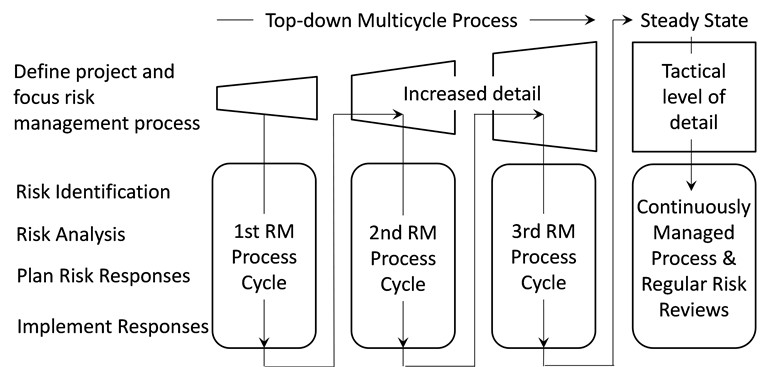A brief guide
Practical Project Risk Management
SERIES ARTICLE
By Martin Hopkinson
United Kingdom
Purposes
- Tailor and evolve the risk management process during the earliest phases of a project.
- Attend to and manage the most fundamentally important sources of risk first.
- Make rapid early progress by gaining key insights from simple high-level risk analysis.
- Make risk-robust and risk-efficient choices when developing project plans.
- Underpin the development of coherent and rational tactical-level risk models and registers.
The Underlying Principle
The risk management process is initiated using simple models with a focus on the most significant sources of risk. Insights from each cycle are used to influence the focus of subsequent cycles as detail is increased. The number of cycles may vary. By way of example, the figure below illustrates three cycles of the process prior to reaching a steady state:

Historical Note
The principle of using a top-down multicycle approach when initiating a project risk management process has been recommended since the 1990s by the APM PRAM Guide and by some leading authors e.g. Chapman and Ward. However, it is still not widely understood, arguably because organisations have favoured the use of tactical-level techniques that are easier to roll-out and that are supported by commercialized project tools.
More…
To read entire article, click here
Editor’s note: This series of articles is by Martin Hopkinson, author of the books “The Project Risk Maturity Model” and “Net Present Value and Risk Modelling for Projects” and contributing author for Association for Project Management (APM) guides such as Directing Change and Sponsoring Change. These articles are based on a set of short risk management guides previously available on his company website, now retired. For an Introduction and context for this series, click here. Learn more about Martin Hopkinson in his author profile below.
How to cite this paper: Hopkinson, M. (2022). Top-down Multicycle Risk Management Process: A brief guide, Practical Project Risk Management series, PM World Journal, Vol. XI, Issue VI, June. Available online at https://pmworldlibrary.net/wp-content/uploads/2022/05/pmwj118-Jun2022-Hopkinson-top-down-multicycle-risk-management-process-series-article.pdf
About the Author

Martin Hopkinson
United Kingdom
![]()
Martin Hopkinson, recently retired as the Director of Risk Management Capability Limited in the UK, and has 30 years’ experience as a project manager and project risk management consultant. His experience has been gained across a wide variety of industries and engineering disciplines and includes multibillion-pound projects and programmes. He was the lead author on Tools and Techniques for the Association for Project Management’s (APM) guide to risk management (The PRAM Guide) and led the group that produced the APM guide Prioritising Project Risks.
Martin’s first book, The Project Risk Maturity Model, concerns the risk management process. His contributions to Association for Project Management (APM) guides such as Directing Change and Sponsoring Change reflect his belief in the importance of project governance and business case development.
In his second book Net Present Value and Risk Modelling for Projects he brought these subjects together by showing how NPV and risk modelling techniques can be used to optimise projects and support project approval decisions. To learn more about the book, click here
To view other works by Martin Hopkinson, visit his author showcase in the PM World Library at https://pmworldlibrary.net/authors/martin-hopkinson/









